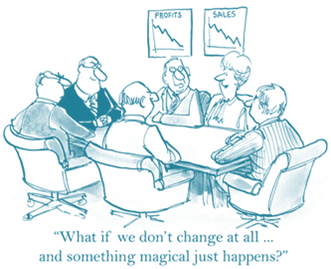


If change is the nature of life, both personal and organizational, then why is it our nature to resist change so vigorously? Over the years, my micro-view from having been involved in mergers and acquisitions, new product distribution, design and development, and enterprise redesign, is that there are two opposing forces at work within the human psyche.
If you are part of the leadership that is implementing the change in an organization, you may favor it, but if you are on the receiving end of the change, fear may make you resistant. In some cases, fear and favor reside in equal measures, no matter what side of the equation you are on. Knowing that without change, atrophy sets in; intellectually we accept change but hope it will happen to others and not to us.
George Bernard Shaw stated, “Progress is impossible without change and if you can’t change your mind, then you can’t change anything.”
So the question is how to address organizational change thoughtfully and favorably alter the minds of people that are resistant. Well, to date we are not doing a very good job. According to the 2013 Strategy&/Katzenbach Center survey of global senior executives on culture and change management, the success rate of major change initiatives is only 54 percent.
Dr. Andi Simon, has just completed a book, called “On the Brink, a Fresh Lens to Take Your Business to New Heights,” which provides case studies that show how change and growth can be accomplished using innovative and creative methods.
While there is no one “secret” to ensure success of a change management program, I have found that a combination of elements within a structured methodology can create guidance and increase the organization’s chance for success.
Here are 5 elements that can ignite the change process and keep it on track.
If we are not talking about changing a culture, as it may be strong, entrenched and valuable and we are creating a transformation within a culture, it is beneficial to begin by finding the elements of the culture that support the change we want accomplished.
1. See things from the staff’s perspective. Anais Nin said, “We don’t see things the way they are, we see things the way we are.” Believing that to be true, it is imperative to involve all staff potentially affected and make them aware of and understand how the proposed changes will alter their work as the data becomes known. Understanding this factor first and foremost will provide insight; are we dealing with fear, favor or ambivalence at differing levels within the organization? Take the pulse of the people involved in the process. Connect with each of them on an ideological basis to articulate:
2. Use both informal and formal leaders to communicate the change, both top-down and bottom up. Don’t be afraid to employ creative approaches to spread the word.
3. Recognize small wins that can be celebrated as you move closer to the long term objective. Find culturally acceptable ways to commemorate.
4. Identify the criteria that indicate successful change and design follow-up and accountability.
5. Create a communication strategy that uses a variety of methods:
Articulating a plan of action whenever change is initiated means that unlike the cartoon at the beginning of the post, we are not waiting for miracles to happen, we are artfully designing them.
If Change is the Nature of Life, Why Do We Resist? ©Carmen Effron
Back